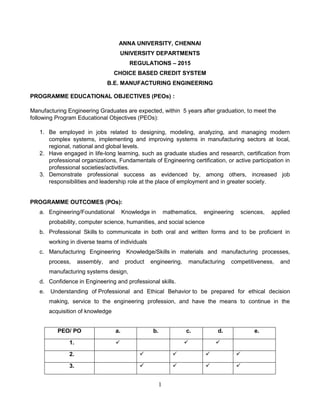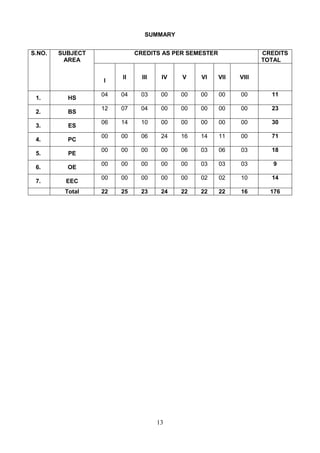This document outlines the curriculum, program objectives, outcomes, and course mappings for a B.E. Manufacturing Engineering program following a Choice Based Credit System. The program aims to produce graduates capable of designing, analyzing, and managing manufacturing systems who engage in lifelong learning and demonstrate professional success and ethics. It consists of 176 credits over 8 semesters of theory and laboratory courses mapping to 5 program outcomes related to engineering fundamentals, professional skills, manufacturing knowledge, confidence, and ethics. Courses cover topics such as mechanics, thermodynamics, materials, manufacturing processes, design, management, and electives.

































































![66
UNIT I INTRODUCTION TO DISASTERS 9
Definition: Disaster, Hazard, Vulnerability, Resilience, Risks – Disasters: Types of disasters –
Earthquake, Landslide, Flood, Drought, Fire etc - Classification, Causes, Impacts including social,
economic, political, environmental, health, psychosocial, etc.- Differential impacts- in terms of
caste, class, gender, age, location, disability - Global trends in disasters: urban disasters,
pandemics, complex emergencies, Climate change- Dos and Don’ts during various types of
Disasters.
UNIT II APPROACHES TO DISASTER RISK REDUCTION (DRR) 9
Disaster cycle - Phases, Culture of safety, prevention, mitigation and preparedness community
based DRR, Structural- nonstructural measures, Roles and responsibilities of- community,
Panchayati Raj Institutions/Urban Local Bodies (PRIs/ULBs), States, Centre, and other stake-
holders- Institutional Processess and Framework at State and Central Level- State Disaster
Management Authority(SDMA) – Early Warning System – Advisories from Appropriate Agencies
UNIT III INTER-RELATIONSHIP BETWEEN DISASTERS AND DEVELOPMENT 9
Factors affecting Vulnerabilities, differential impacts, impact of Development projects such as
dams, embankments, changes in Land-use etc.- Climate Change Adaptation- IPCC Scenario and
Scenarios in the context of India - Relevance of indigenous knowledge, appropriate technology
and local resources
UNIT IV DISASTER RISK MANAGEMENT IN INDIA 9
Hazard and Vulnerability profile of India, Components of Disaster Relief: Water, Food, Sanitation,
Shelter, Health, Waste Management, Institutional arrangements (Mitigation, Response and
Preparedness, Disaster Management Act and Policy - Other related policies, plans, programmes
and legislation – Role of GIS and Information Technology Components in Preparedness, Risk
Assessment, Response and Recovery Phases of Disaster – Disaster Damage Assessment.
UNIT V DISASTER MANAGEMENT: APPLICATIONS AND CASE STUDIES AND FIELD
WORKS 9
Landslide Hazard Zonation: Case Studies, Earthquake Vulnerability Assessment of Buildings and
Infrastructure: Case Studies, Drought Assessment: Case Studies, Coastal Flooding: Storm Surge
Assessment, Floods: Fluvial and Pluvial Flooding: Case Studies; Forest Fire: Case Studies, Man
Made disasters: Case Studies, Space Based Inputs for Disaster Mitigation and Management and
field works related to disaster management.
TOTAL: 45 PERIODS
OUTCOMES:
The students will be able to
Differentiate the types of disasters, causes and their impact on environment and society
Assess vulnerability and various methods of risk reduction measures as well as
mitigation.
Draw the hazard and vulnerability profile of India, Scenarious in the Indian context,
Disaster damage assessment and management.
TEXTBOOK:
1. Singhal J.P. “Disaster Management”, Laxmi Publications, 2010. ISBN-10: 9380386427
ISBN-13:978-9380386423
2. Tushar Bhattacharya, “Disaster Science and Management”, McGraw Hill India Education
Pvt.Ltd., 2012. ISBN-10: 1259007367, ISBN-13: 978-1259007361]
3. Gupta Anil K, Sreeja S. Nair. Environmental Knowledge for Disaster Risk Management,
NIDM, New Delhi, 2011
4. Kapur Anu Vulnerable India: A Geographical Study of Disasters, IIAS and Sage Publishers,
New Delhi, 2010.
REFERENCES
1. Govt. of India: Disaster Management Act , Government of India, New Delhi, 2005
2. Government of India, National Disaster Management Policy,2009.](https://image.slidesharecdn.com/2015-231008115640-6dfafffb/85/2015-pdf-66-320.jpg)































![98
of S/W Program - Types of Prototypes, S/W Testing- Hardware Schematic, Component
design, Layout and Hardware Testing – Prototyping - Introduction to Rapid Prototyping and
Rapid Manufacturing - System Integration, Testing, Certification and Documentation
UNIT IV SUSTENANCE ENGINEERING AND END-OF-LIFE (EOL) SUPPORT 9
Introduction to Product verification processes and stages - Introduction to Product Validation
processes and stages - Product Testing Standards and Certification - Product Documentation
- Sustenance -Maintenance and Repair – Enhancements - Product EoL - Obsolescence
Management – Configuration Management - EoL Disposal
UNIT V BUSINESS DYNAMICS – ENGINEERING SERVICES INDUSTRY 9
The Industry - Engineering Services Industry - Product Development in Industry versus
Academia –The IPD Essentials - Introduction to Vertical Specific Product Development
processes -Manufacturing/Purchase and Assembly of Systems - Integration of Mechanical,
Embedded and Software Systems – Product Development Trade-offs - Intellectual Property
Rights and Confidentiality – Security and Configuration Management.
TOTAL: 45 PERIODS
OUTCOMES:
Upon completion of the course, the students will be able to:
Define, formulate and analyze a problem
Solve specific problems independently or as part of a team
Gain knowledge of the Innovation & Product Development process in the Business
Context
Work independently as well as in teams
Manage a project from start to finish
TEXTBOOKS:
1. Book specially prepared by NASSCOM as per the MoU.
2. Karl T Ulrich and Stephen D Eppinger, "Product Design and Development", Tata McGraw
Hill, Fifth Edition, 2011.
3. John W Newstorm and Keith Davis, "Organizational Behavior", Tata McGraw Hill,
Eleventh Edition, 2005.
REFERENCES:
1. Hiriyappa B, “Corporate Strategy – Managing the Business”, Author House, 2013.
2. Peter F Drucker, “People and Performance”, Butterworth – Heinemann [Elsevier], Oxford,
2004.
3. Vinod Kumar Garg and Venkita Krishnan N K, “Enterprise Resource Planning –
Concepts”, Second Edition, Prentice Hall, 2003.
4. Mark S Sanders and Ernest J McCormick, "Human Factors in Engineering and Design",
McGraw Hill Education, Seventh Edition, 2013](https://image.slidesharecdn.com/2015-231008115640-6dfafffb/85/2015-pdf-98-320.jpg)
